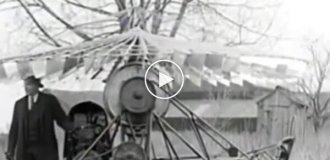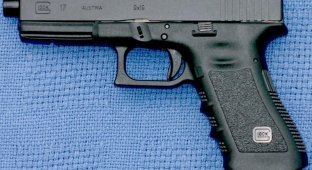The Walther P38 is rightfully considered one of the best pistols of World War II. But for some reason it is usually ignored.

The history of one of the most famous German pistols, the Walther P.38, begins with the emergence in the 1920s of the need to adopt a new standard short-barreled personal weapon for the Reichswehr, which was forced to limit its weapons to the terms of the Versailles Peace Treaty. In 1929, German gunsmiths secretly began work on creating a new generation of pistols with modern combat and performance qualities. This weapon was planned to be adopted by the army, but design work was carried out under the guise of creating service pistols for the police. The first step in this area was to adapt the Walther PP pistol to fire 9mm Parabellum cartridges. The pistol, which was essentially an enlarged version of the prototype, was named Walther MP (Militarpistole). However, tests have shown the impossibility of using a powerful cartridge in a blowback weapon. After a short break, work on creating a new pistol was resumed with the Nazi Party coming to power in 1933. Strengthening the army and navy, preparing the armed forces for a new war, and the desire to supply the troops with new, more advanced weapons promised large military orders to arms manufacturers.
Pistol Walther P.38 manufactured by Mauser-Werke A.G. has code "byf 42"

As a result, the company Carl Walther Waffenfabrik GmbH in 1935 introduced a new model of a combat pistol, based on a new concept, design and production technology, which received the same designation as the previous version - Walther MP. The features of the pistol were a short open-type bolt-casing, a new design of such parts as an indicator of the presence of a cartridge in the chamber, a firing pin and ejector, as well as a double-action trigger mechanism, a hammer type, with a hidden trigger. The tests carried out showed the presence of design flaws, which was not surprising, since the barrel bore was locked using the same free bolt. Work on MP was stopped. However, soon, thanks to the patent of Fritz Walter and Fritz Barthlemens for a locking system using a combat cylinder swinging in a vertical plane, received in October 1936, a new pistol was designed at Walther Waffenfabrik GmbH, which laid the basis for the design of the future standard weapon of the Wehrmacht.
Walther AP pistol

Walther AP pistol

This pistol was designated Walther AP (Armeepistole, German - army pistol). It was produced in 1936-1937, becoming the first Walter model to have an automatic mechanism that worked according to the scheme of using recoil with a short barrel stroke. The AP also used a short open-type bolt-casing and a double-action trigger mechanism with a hidden trigger. The pistol was equipped with two return springs, horizontally located on both sides of the frame. The number of pistols produced was insignificant - only 100 copies for testing. In general, the weapon performed well and had good fighting qualities. However, after tests carried out in the spring of 1937 at the Kummersdorf training ground, the military spoke out against the hidden location of the trigger, since, in their opinion, it was impossible to visually determine whether the weapon was loaded or not, after which the designers began to refine the pistol.
Walther P38 pistol manufactured in 1941, left view

The next step was the creation in 1937 of the HP model (Heerespistole, German - military pistol). It was a slightly improved AP with an open hammer and a slightly modified bolt-casing design. HP was produced in several calibers. Pistols for the army were made for various 9mm Parabellum cartridges. The variant chambered for the 7.65mm Parabellum cartridge for the civilian arms market is extremely rare, as only 95 of them were produced. In a small series of 230 copies, the HP was produced with a single-action trigger mechanism, chambered for the same 7.65 mm cartridge. According to some information, there were also pistols chambered for .45 ACP, manufactured for sale in the USA. In addition to HP, pistols from leading German arms companies such as Mauser-Werke A.G. and J.P. took part in competitive tests of weapons control held in 1938. Sauer & Sohn. As a result of a series of tests, victory was awarded to weapons from Walther Waffenfabrik GmbH. The new pistol was considered suitable for the armed forces of the Third Reich, however, subject to several design changes to optimize large-scale production. Now, when the war was already very close, the question of a new army pistol was more pressing, since the Wehrmacht needed cheaper weapons with a high rate of mass production. As with the Parabellum, the German army was not the first to use the new German pistol with superior combat and performance qualities. A small batch of HP was purchased by Sweden in 1938.
Walther HP pistol

Walther HP pistol

The modified HP pistol with a slightly improved safety mechanism was adopted by the Wehrmacht on April 20, 1940 as a standard service pistol under the designation Pistole P.38 (pistol model 1938) or P.38. The adoption of the new pistol was caused by the high labor costs and production costs of the P.08, which were especially unacceptable in wartime conditions. In April 1940, the first batch of 1,500 P.38s was produced. Until the beginning of the summer of 1940, Walther Waffenfabrik GmbH produced about 13,000 pistols of the zero series, the distinctive features of which were black plastic grip cheeks with a fine cross diamond-shaped notch and a small round swivel. The P.38 used the standard 9mm Parabellum cartridge. A variant chambered for the 7.65mm Parabellum cartridge was produced in small quantities. There were also experimental, single copies that used .45 ACP and .22LR cartridges. The first P.38 had polished outer surfaces of steel parts, coated with oxidation, the company logo and address, model and caliber designation on the left surface of the bolt casing. Subsequently, all designations were replaced by a code, for example, “480”, “ac”, “ac41”, “ac42”, etc. New weapons were received by officers of the ground forces, part of the non-commissioned officers, the first numbers of heavy weapons crews, officers SS field troops, as well as the SD security service, the Main Office of Reich Security and the Reich Ministry of the Interior. In the early period of the war, about 17,000 HP pistols were also produced.

The attack on the USSR in 1941, followed by large-scale hostilities on the Eastern Front, caused large losses in personal weapons, which required an increase in production volumes. However, Walther Waffenfabrik GmbH did not have sufficient production capacity, as a result of which it had to take extreme measures - transferring documentation and a license to produce a pistol to competitors. Mauser-Werke A.G. began production in September 1942, Spree-Werke GmbH - in May 1943 at plants in Spandau and in the Czech city of Hradkov nad Nisou and at a subsidiary in Zittau Grottau. Pistols produced by Mauser-Werke A. G. received the code designation “byf”, for example “byf 43”, which had gray steel parts due to phosphating surface treatment and were distinguished by brown Bakelite handle cheeks. Pistols with codes “byf 42”, “byf 43” and “byf 44” are among the most common, after the products of Walther Waffenfabrik GmbH. At the very end of the war, Mauser-Werke A. G. produced the P.38 with the code "svw 45". Weapons produced by Spree-Werke GmbH received the marks “cyq”, and since 1945 - “cvq”. In the summer of 1943, the design of the pistol was changed. At this time, the Walther Waffenfabrik GmbH brand was branded “ac43”. Due to some thickening, the frame in the area of the trigger axis was strengthened, and the groove for the ejector became semicircular instead of rectangular. In the same year, frames were produced with a surface treated with cheap oxidation, which gave a copper tint, and the cheeks of the handle began to be made of bakelite, also called phenolic resin.
Walther P.38 pistol manufactured by Spree-Werke GmbH with code "cyq"

In addition to this, under the supervision of German specialists, other European weapons manufacturers were also involved in the production of the P.38: the Belgian Fabrique Nationale d'Armes de Guerre and the Czech Zbrojovka Brno produced bolt casings and frames; the old German arms company C. G. Haenel Waffen und Fahrradfabrik AG and the Czech factory Erste Nordbohmische Waffenfabrik produced stores; the Czech arms concern Bohmische Waffenfabrik AG produced the barrels. Thanks to the measures taken, it was possible to significantly increase the production volume of pistols. In 1944, the Main Directorate of Reich Security - RSHA (Reichssicherheitshauptamt - RSHA) ordered a batch of shortened P.38 pistols for the needs of the SS, Gestapo and SD. However, the order was not carried out by Carl Walther GmbH, but by Spree-Werke GmbH. Such pistols no longer had the signature Walter emblem in the form of a flag; such weapons are distinguished by the “cyq” brand. Several thousand shortened versions of the P.38 were produced, designated P.38 K. The barrel length of these pistols was 72 mm. The front sight is made integral with the bolt-casing and is part of it. The rear sight, however, was adjustable.

The automation works according to the scheme of using recoil with a short barrel stroke. The barrel bore is locked using a combat cylinder swinging in a vertical plane. The cylinder, interacting with the pistol frame, moves down, releasing the bolt casing. Next, the barrel with the cylinder stops in the rearmost position, while the bolt-casing continues its rollback, extracting the spent cartridge case, and then sending the next cartridge into the chamber while moving back forward. There are two return springs located in the gun frame. Trigger-type trigger, double action, with release and safety cocking of the hammer. The trigger pull when shooting with a pre-cocked hammer is 2.5 kg, when shooting with a self-cocking hammer - 6.5 kg. The safety lever, the lever of which is located on the left side of the bolt-casing, blocks the firing pin and at the same time safely releases the trigger. The barrel protrudes halfway from the short open-type bolt-casing. The bolt stop lever is located on the left side of the frame, and in front of it, on the same side, there is a barrel lock used when disassembling the pistol.
For use by the German intelligence services, various types of silencers were developed for the Walther P.38.

The weapon is equipped with an indicator of the presence of a cartridge in the chamber, similar in design to that of the PP pistol. A single-row magazine with a capacity of eight rounds is secured in the handle located at the bottom with a latch. The plastic cheeks of the handle initially had a fine diamond-shaped notch and were black in color, but during the war they began to be produced from a special plastic - bakelite, which had a brown color. Such cheeks received a large notch in the form of wide horizontal grooves. The P.38 used two types of protective coating - phosphating and oxidation. In the beginning, expensive polishing followed by oxidation was used, but this surface treatment was soon replaced by a cheaper one by the end of 1941. During the war, phosphated pistols were gray or light gray in color, and weapons of post-war production were dark gray. The surface of steel parts of pistols that had undergone factory repairs with the application of a new coating was treated with oxidation, after which the weapon had a black color.
Before the R.38 became like this, it went through a long evolutionary path. But the creators’ efforts were not in vain. According to many experts, this pistol became the best military pistol of the Second World War.

Combat use of the P.38 showed firing efficiency, fairly high operational reliability, a high degree of safety in handling and good shooting accuracy. This weapon was used by all sides at war, and the P.38 was subsequently recognized by many experts as the best military pistol of World War II. Among officers and soldiers, this outstanding pistol has proven itself to be easy to use and operate, durable, reliable and accurate. Its advantages were an excellent combination of combat and service qualities for its time. The weapon was safe when loaded; the owner could open fire at any time or determine by touch whether the gun was loaded. But, despite the traditional high quality of workmanship and other positive qualities for German weapons, the P.38 still had several rather significant shortcomings, due to which it was not copied by other manufacturers in its original form. As well as high quality, German weapons are also characterized by sophistication, which was also evident in the P.38. There are a lot of springs in the pistol, you just have to remember the two return springs, not to mention the rest - only 11 versus 7 for the Parabellum pistol. The locking mechanism, although it ensures straight-line movement of the barrel during recoil, is bulky and quite difficult to manufacture. P.38 is overly thick for a pistol with a single-stack magazine. The trigger is quite complex in design and is distinguished by a significant trigger force when firing by self-cocking.
Walther P.38 "byf 43", manufactured by Mauser-Werke A. G.

The safety reliably protected the pistol owner from accidental shots while carrying the weapon. However, practice has shown that the flag fuse, along with its positive qualities, also has a big drawback. There are numerous cases where in battle, in a stressful situation, the shooter forgot to turn off the safety, the consequences of which are unnecessary to talk about. The trigger mechanism, borrowed from PP pistols, also requires high precision in manufacturing. When producing USM parts, it was necessary to pay special attention to the quality of the steel used and its heat treatment. Eight rounds in a single-stack magazine are too few by modern standards and requirements for a combat pistol. In addition, the weapon has a large width, which prevents concealed carry. However, all these shortcomings did not prevent the pistol from becoming one of the most popular among soldiers of all the armies that fought and a coveted trophy. In total, 1,180,000 pistols of this model were produced during the war years.
Walther P.38 designated "byf 44", produced in 1944

After the end of the war, production was resumed for some time at the initiative of the French occupation forces for their army and police. Due to reparations, the factory equipment of Walther Waffenfabrik GmbH was also exported to the USSR, Czechoslovakia, Yugoslavia and Poland. The same fate befell the production equipment of Mauser-Werke A.G. But after the occupation, these factories produced P.38s in 1945-1946. continued to be collected for the French police and army, which from 1946 to 1955 fought the war in Indochina. Such pistols were distinguished by a brand in the form of a “French star” on the right side of the bolt casing. In 1946, at the Czech former Spree-Werke production facility, approximately 3,000 pistols, distinguished by the designation “46” on the right side of the trigger guard, were assembled from a stock of parts, which were then supplied to the Czechoslovak Army. Such pistols are known as Vz46. The restored Austrian armed forces also used P.38 and HP pistols with the "BH" stamp. The Walter company, recreated in the city of Ulm an der Donau, by the end of the 1950s again began manufacturing the P.38 for the armed forces of the Federal Republic of Germany - the Bundeswehr, but there was no longer a dot in the designation of this weapon; the pistol was now designated as P38. These pistols were produced for export in small quantities and without any changes.
Pistol Walther P.38 K

In 1957, the Bundeswehr adopted a new version of the P.38, differing from the old one only in the frame made of an aluminum-based alloy. The Bundeswehr then consisted mainly of former Wehrmacht soldiers who did not want any other pistol than their good old service P.38. Therefore, no competition was held to adopt a new type of personal weapon and the old pistol began service under the new designation P1 in 1963. That same year, another design change was made. The barrels had a pressed-in cylindrical insert with rifling, called a liner. Since November 1967, the thickness of each of the walls of the shutter-casing was already 3 mm, instead of the previous 2.5 mm. The number of notches increased - from 15 to 26. In June 1975, a steel hexagonal insert was introduced into the frame design to strengthen it, which served as a stop for the barrel lock. Pistols for the civilian arms market were designated P38.
Walther P.38 pistol with the designation "ac 45"

The next modification appeared in 1975 under the designation P4. This pistol had a shortened barrel, and an automatic firing pin safety was introduced into the design. The safety catch was also redesigned, which now did not block the trigger and, having safely released the trigger, returned to its original position. P4 was produced until 1982. Soldiers of the German special forces to combat terrorism needed a small pistol for concealed carry. Especially for this purpose, Walter launched a small-scale production of a shortened version under the designation P38K. From 1974 to 1981 Only about 1,500 of these pistols, similar to the P.38 K manufactured at one time for the SS and Gestapo, were produced. 200 of them used the 7.65mm Parabellum cartridge. In East Germany - the GDR - the P.83 was also used, in particular, a shortened version was in service with the Ministry of State Security (Ministerium f?r Staatssicherheit) or “Stasi” for short. During serial production in Ulm, various small parts of the pistol, such as the bolt stop lever, reflector, magazine, sights and firing pin, were subject to minor changes in the material of manufacture and the shape of the parts. The P38 and P1 pistols were produced until 1992. Commercial production continued until 2000. P.38 of both military and post-war production are found in Sweden, Norway, Austria, Pakistan, Lebanon, Chile, South Africa, Mozambique and other countries of the world.
























